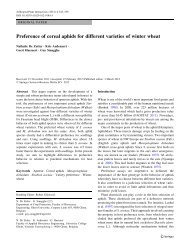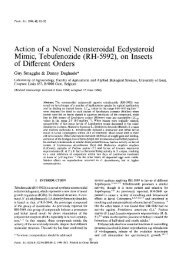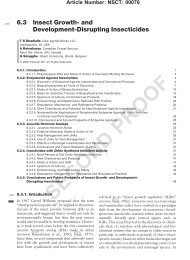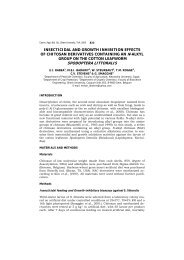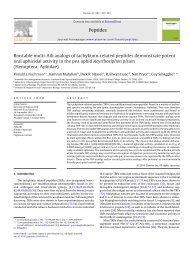Mode of action of etoxazole - ResearchGate
Mode of action of etoxazole - ResearchGate
Mode of action of etoxazole - ResearchGate
You also want an ePaper? Increase the reach of your titles
YUMPU automatically turns print PDFs into web optimized ePapers that Google loves.
R Nauen, G Smagghe<br />
2.2 Insecticides and chemicals<br />
The <strong>etoxazole</strong> and triflumuron used were <strong>of</strong> technical<br />
grade with purities <strong>of</strong> >98% and were obtained<br />
in-house. N-Acetyl-D-[1- 14 C]glucosamine (GluNAc)<br />
with a specific activity <strong>of</strong> 2.17 GBq mmol −1 was<br />
purchased from Amersham BioSciences (Piscataway,<br />
NJ, USA). All other chemicals and solvents were <strong>of</strong><br />
analytical grade and obtained from Sigma (Heidelberg,<br />
Germany) or Merck (Darmstadt, Germany).<br />
2.3 Gravimetric ex vivo determination <strong>of</strong> chitin<br />
deposition in larvae <strong>of</strong> Spodoptera frugiperda<br />
exposed to insecticide-treated leaves<br />
Stock solutions <strong>of</strong> insecticides (1000 mg litre −1 )were<br />
prepared in aqueous Triton X-100 solution (0.2 g<br />
litre −1 ) and diluted accordingly. Circular leaf discs<br />
(44 mm in diameter) cut from true leaves <strong>of</strong> 3-weekold<br />
cabbage plants, Brassica olearacea L., were dipped<br />
for 3 s in insecticidal solutions and transferred to petri<br />
dishes containing a filter paper disc. Subsequently a<br />
single freshly ecdysed sixth-instar larva <strong>of</strong> S. frugiperda<br />
(165–190 mg) was transferred to each leaf disc. Four<br />
freshly ecdysed sixth-instar larvae were directly frozen<br />
at −80 ◦ C and served as 0 h controls. Larvae were<br />
weighed and fed daily with fresh leaf discs (either<br />
treated or untreated), and after 3 days at least three<br />
groups <strong>of</strong> four larvae per test concentration (including<br />
untreated controls) were assessed for symptoms <strong>of</strong><br />
poisoning and frozen at −80 ◦ C. After thawing, larvae<br />
were dissected and integuments free <strong>of</strong> adhering tissue<br />
(4–12 replicates per concentration) were dried for<br />
2 h at 110 ◦ C. The integuments were weighed and<br />
subsequently treated individually with boiling aqueous<br />
potassium hydroxide (2.5 M,2ml)for2h.Afterwards,<br />
integuments were washed with deionised water (2 ml),<br />
hydrochloric acid (0.5 M, 2 ml) and ethanol (2 ml).<br />
The remaining residue (chitin) was dried for 2 h at<br />
100 ◦ C and weighed. The experiment was repeated at<br />
least two times.<br />
Examination for symptoms <strong>of</strong> poisoning was<br />
conducted with fifth-instar larvae using the same<br />
bioassay, except that larvae were not analysed for<br />
integumental chitin content.<br />
2.4 Inhibition <strong>of</strong> incorporation <strong>of</strong><br />
[ 14 C]N-acetyl-D-glucosamine into cultured<br />
integuments <strong>of</strong> Spodoptera frugiperda<br />
Early sixth-instar larvae <strong>of</strong> S. frugiperda were selected<br />
and used for the preparation <strong>of</strong> integument fragments.<br />
Procedures were basically the same as described<br />
by Nakagawa et al. 5 After surface sterilisation <strong>of</strong><br />
larvae with 75% ethanol for 15 min, six integument<br />
fragments <strong>of</strong> about 20 mm 2 were dissected aseptically<br />
and incubated first at 27 ◦ C in 1 ml <strong>of</strong> sterile Grace’s<br />
medium containing 2.2 µM 20-hydroxyecdysone (20E)<br />
but not antibiotics or Bovine serum albumine (BSA).<br />
After 24 h culture the fragments were transferred to<br />
another sterile culture well containing 1 ml <strong>of</strong> Grace’s<br />
medium with 0.2 nmol <strong>of</strong> 14 C-GluNAc but not<br />
containing 20E. These conditions were chosen based<br />
on earlier experiments. 5 To test the effects <strong>of</strong> <strong>etoxazole</strong><br />
and triflumuron, 1 µl aliquots <strong>of</strong> solutions <strong>of</strong> each<br />
compound in dimethyl sulfoxide (DMSO) were added<br />
to the culture wells to give a final concentration range<br />
from 10 −10 to 10 −4 M. The integument fragments were<br />
further incubated in the medium at 27 ◦ Cfor72h.<br />
After incubation the culture medium was removed<br />
from the well and the pieces <strong>of</strong> integument were<br />
washed with deionised water (3 × 0.5ml).Tomeasure<br />
the 14 C activity in the cultured tissues, integument<br />
pieces were treated with an alkaline solution, washed<br />
three times with distilled water and treated overnight<br />
with tissue solubiliser in 20 ml glass liquid scintillation<br />
vials. The amount <strong>of</strong> radiolabel was measured with<br />
Ultima Gold cocktail (PerkinElmer LifeSciences,<br />
Wellesley, MA) in a liquid scintillation counter as<br />
described elsewhere. 6<br />
Based on the dose–response curve, the activity<br />
was expressed as pIC 50 , the negative decadic<br />
logarithm <strong>of</strong> the mean concentration causing 50%<br />
inhibition <strong>of</strong> the incorporation <strong>of</strong> 14 C-GluNAc into<br />
the integument parts, using sigmoidal curve fitting<br />
<strong>of</strong> GraphPad Prism s<strong>of</strong>tware (Statcon, Witzenhausen,<br />
Germany). Data are results <strong>of</strong> two repeat<br />
measurements, and for each compound seven concentrations<br />
were tested (n = 14). The goodness <strong>of</strong><br />
fit was expressed as R 2 . The 0% effect (highest<br />
amount <strong>of</strong> incorporated radiolabel without inhibitor)<br />
was 1622 dpm; the 100% effect (lowest amount <strong>of</strong><br />
incorporated radiolabel with 10 −4 M triflumuron) was<br />
402 dpm.<br />
3 RESULTS AND DISCUSSION<br />
3.1 Effects <strong>of</strong> <strong>etoxazole</strong> on Spodoptera<br />
frugiperda larvae<br />
Potency-wise, <strong>etoxazole</strong> is a strong acaricide and<br />
much less effective against fall armyworm larvae<br />
than benzoylphenylureas such as triflumuron, which<br />
has no acaricidal activity. However, physiological<br />
and biochemical mode <strong>of</strong> <strong>action</strong> investigations with<br />
juvenile spider mites are very difficult to conduct.<br />
Therefore we have chosen S. frugiperda as an<br />
appropriate model insect which is readily affected by<br />
<strong>etoxazole</strong>, thus allowing us to study the mode <strong>of</strong> <strong>action</strong><br />
more closely.<br />
Fifth-instar larvae <strong>of</strong> the fall armyworm feeding<br />
on cabbage foliage treated with <strong>etoxazole</strong> responded<br />
with obvious signs <strong>of</strong> moulting defects in a dosedependent<br />
manner after 3 days, i.e. <strong>etoxazole</strong> was<br />
acting slowly like an insect growth regulator. 7 Most<br />
prominent symptoms were a double head capsule due<br />
to the inability to shed the old one, and incomplete<br />
ecdysis with subsequent loss <strong>of</strong> haemolymph<br />
on the interface between the new head capsule and<br />
thethoracicsegments.Thetreatment<strong>of</strong>fallarmyworm<br />
larvae with <strong>etoxazole</strong> resulted in symptoms <strong>of</strong><br />
poisoning similar, if not identical, to those <strong>of</strong> the benzoylphenylurea<br />
insecticide triflumuron (Fig. 1). The<br />
380 Pest Manag Sci 62:379–382 (2006)<br />
DOI: 10.1002/ps




